Mazda’s CX-3 Sets Compact SUV Standard
Filed under: Equinox, Autos
By John Gilbert
The new Mazda CX-3 is fouling up some long-standing family logic. While test-driving the proliferating array of trucks and SUVs has always been enjoyable and educational, our preference is for the dynamics of lower and sleeker cars, and the theory remains that anything bigger than “big enough” is too big.
But in the last couple of years, two pivotal new ingredients have evolved: One is age, on our part; the other is downsizing, on the part of the auto industry. Those two elements create an intriguing new junction for our consideration — to say nothing of millions of others. Without excessive size, you can still get SUV assets of a slightly higher vehicle with better visibility that’s easier to get into and out of, and has all-wheel drive to easily conquer the worst of Up North winters.
A couple of years ago, Mazda made it tempting with the CX-5, a pleasingly compact crossover SUV. We drove it around Mazda Raceway at Laguna Seca, where its agility and power felt more like a sporty car. A compact SUV with the highest of high-tech power and features.
“Hmmmm,” we hmmmed. The CX-5 was the first vehicle that incorporated the full effect of Mazda’s fantastic Skyactiv technology, a holistic approach to building engines, transmissions, all-new suspension, a creative all-wheel-drive system, and an aerodynamic chassis and body and interior all in unified harmony — a concept that has followed in every Mazda vehicle since.
And now, for 2016, along comes the CX-3, significantly smaller than the CX-5 but still with more than adequate room and a bold, fresh design. Mazda officials say not to consider it a downsized CX-5, or a taller Mazda2, upon whose platform the CX-3 is based.
We may be hooked. Amid an armada of new and downsized “CUVs,” the CX-3 was introduced as an early 2016 model, right after the compacted Jeep Renegade, right about the same time as the new and diminutive Honda HR-V, and just before the Fiat 500X and Hyundai Tucson. After brief exposure, the CX-3 might be the pick of the new litter.
The CX-3 blends all the features that convince mainstream buyers they need, as well as want, an SUV. If the CX-5 handles like a sporty sedan, the CX-3 is lighter, lower, better balanced and handles even better. Its looks makes you realize it is in the CX-5 family, and it has the large grille is the new identity face of all things Mazda. But its confluence of contours and exterior lines makes the CX-3 stand alone.
At 168.3 inches long, the CX-3 comes in various forms. The basic Sport starts at $19,950, the Touring starts at $21,950, and the GT starts at $24,990. All-wheel drive adds $1,200. A fully loaded GT version can be had for $28,160. All have the same 2.0 engine. The midrange Touring includes cross-traffic rear camera view, and the GT adds 18-inch wheels, LED lighting, paddle shifters, and leather seats with suede trim.
Also available are lane departure and blind spot warning, a moonroof, crash mitigation, adaptive headlights, remote start, and the ability to go beyond normal Bluetooth to social networking and communicating via e-mails. It even offers a car-finder device that can be programmed into your smartphone.
Under the hood, the CX-3 has Mazda’s exceptional 2.0-liter Skyactiv 4-cylinder, which is the smaller of two new 4s that power all the Mazda sedans as well as the CX-5. It doesn’t seem to give up any performance to its larger brother, and it can achieve heroic gas mileage figures consistently over 30 miles per gallon, thanks to delayed valve timing and its extremely high compression ratio while still burning regular gas.
All that helps Mazda fool you with performance that outhustles the simple figures of a mere 146 horsepower and 146 foot-pounds of torque. That sounds mild, but the thorough combustion of Skyactiv technology reinforces another Mazda tradition: If it feels powerful enough, it is powerful enough.
Behind the wheel, acceleration is brisk, and fuel economy shows 29 city and 35 highway estimates with front-wheel-drive models, and 27 city, 32 highway with heavier all-wheel drive. One big asset is the 6-speed transmission Mazda built in-house to incorporate with its Skyactiv breakthrough is smooth and sure in its shifting and makes the CX-3 feel much quicker than several competitors, particularly those deploying CVTs — continuously variable transmissions.
In addition, there are steering-wheel remote paddles and a Sport mode to closely simulate manual shifting by holding gears in the sweet spot of the torque range, while also matching revs on downshifts, and recognizing hills and terrain where more-aggressive or more cautious shifting might be appropriate.
Part of its CX-3’s lightness comes from a combination of 63 percent high-tensile steel in the body, with the remainder ultra-high-tensile. Mazda includes its safety ring structure, which features a straight frame with rings running around the belittling and also from top to bottom along the A and B pillars, surrounding the occupant compartment with high-tensile steel. The design distributes any impacting force to the lower perimeter of the chassis.
My personal preference for interior design always has been to keep it simple, and the CX-3 wins there, too, with a horizontal dash accented by a 7-inch center nav screen, and a neat heads-up display screen on the dash in front of the driver. The factory navigation system costs $400.
The all-wheel drive system is a unique unit that Mazda calls “i-Activ.” Stan Hortinel, an engineer who was production manager on the CX-3, said the system reads steering angle and input, and also calculates other elements including temperature and brake fluid pressure.
“On dry pavement, and at normal temperatures, the system uses wheel-speed sensors to read the surface and anticipate cornering, and can switch torque to help maintain traction,” Hortinel said. “If there’s water on the road, it reads the power you’re using and the steering as well as the friction, so when you hit water the CX-3 detects it and predicts rather than reacting.
“It’s the same when there is snow and ice on the road. Your wheel-speed changes and the car’s response changes, based on the temperature sensors and steering wheel angle. The system takes in all the information and applies the torque properly to each wheel.”
Reinforcing that explanation, which is a key for anyone who drives in changing seasons, production engineer Jacob Brown said: “With the all-wheel drive system, there is never 100 percent of the torque going to the front wheels. Maybe, in perfect conditions, as much as 98 percent might go to the front, but even something as slight as a slight incline or decline would cause more power to go to the rear.”
Up to 50 percent of the power can go to the rear under slippery conditions. The system was introduced on the larger CX-5 two years ago, and weighing in 20 percent lighter than its big brother, at a mere 2,932 pounds, the system works impressively on the CX-3.
At the CX-3 introduction, at Westlake Village, California, Mazda showed video comparisons where Subaru’s system allowed a lot of slipping and the Honda system proved more reactive than anticipatory.
In dry weather, the front-wheel drive CX-3 is lighter and sportier to fling around curves, but the all-wheel drive models not only feel more planted in cornering maneuvers, but add another asset for those of us in the north country. All the more enticing to former car families.
XC90 Hauls Volvo to Elite SUV Status
Filed under: Equinox, Autos
By John Gilbert
The Volvo XC90 is an automotive rarity. While it is entirely new for 2016, it combines every contemporary and futuristic new element together in perfect harmony to make a whole that is far greater than just the sum of its parts.
The new XC90 is the largest Volvo, and as large SUVs go, it might be my favorite. Understand that I really like small, compact crossover SUVs, and with the herd of new ones hitting the market this year, I am a long way from determining a favorite among the smaller “CUV” group. With larger SUVs, I have less hesitation: The 2016 XC90 is so loaded with technical, aesthetic, performance, comfort, and safety features that anybody looking for a luxury SUV should be urged to consider it.
My impression from the first photos I saw was, “So this is what would happen if Volvo tried to build a Tahoe?” Thus, I was pleased to be invited for the introduction of the new XC90 in Santa Monica, Calif., because the vehicle is vastly more impressive in real-life than in those first photos. Yes, it is bigger and a bit more squarish than the more curvaceous original XC90. But in person, it looks classy, not boxy; stylish, not stodgy.
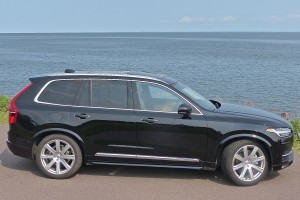
The 2016 XC90 uses its squarish exterior to house a full array of comfort, performance and luxury features.
At 194.8 inches in length, the XC90 is 10 inches shorter than a Tahoe, and 30 inches shorter than a Suburban, but it makes excellent use of its interior space and can tow up to 5,000 pounds with engine choices that include 400 horsepower and 372 foot-pounds of torque.
As unique as the exterior looks, that might be the least impressive of the new XC90’s assets. It comes in three designations — the Momentum, the Inscription, and the R-Design. Each can be had with the choice of engines: the T6, which is a new and sophisticated 2.0-liter 4-cylinder with both supercharging for low-end thrust and turbocharging for high-end power, or the T8 “twin engine” alternative, which has the same T6 engine linked to a C-ISG battery pack/electric motor unit to generate electricity for the latest in hybrid technology.
The T6 produces 316 horsepower and 295 foot-pounds of torque and will zip from 0-60 in about 6 seconds with an EPA fuel economy estimate of 22 miles per gallon. The T8 produces 400 horsepower and 472 foot-pounds, improving acceleration time to 5.6 seconds and attaining a lofty 59 mpg high. With both engines available in all three models, all can be obtained in basic form or with popular options grouped in Vision, Convenience, or Climate packages, and a full slate of specific options also are available.
Prices for well-equipped standard vehicles range from $48,900 for the Momentum T6 or $68,100 with the T8; the high-performance R-Design ranges from a $52,900 base T6 to $70,000 for the T8; and the Inscription opens at $54,500 as a T6 or $71,600 for the T8.
Read more


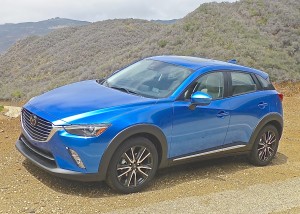
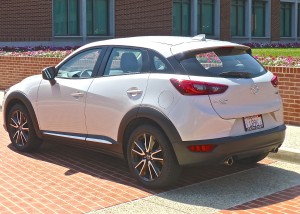
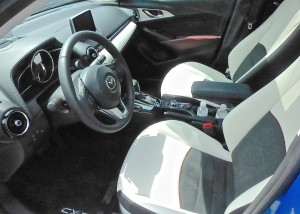


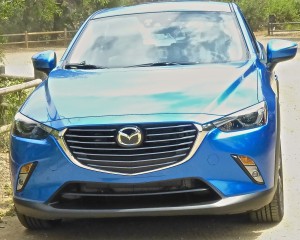
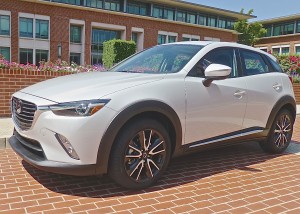
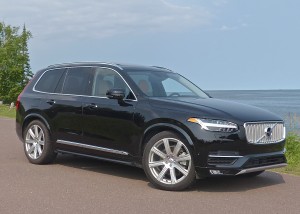
 John Gilbert is a lifetime Minnesotan and career journalist, specializing in cars and sports during and since spending 30 years at the Minneapolis Tribune, now the Star Tribune. More recently, he has continued translating the high-tech world of autos and sharing his passionate insights as a freelance writer/photographer/broadcaster. A member of the prestigious North American Car and Truck of the Year jury since 1993. John can be heard Monday-Friday from 9-11am on 610 KDAL(www.kdal610.com) on the "John Gilbert Show," and writes a column in the Duluth Reader.
John Gilbert is a lifetime Minnesotan and career journalist, specializing in cars and sports during and since spending 30 years at the Minneapolis Tribune, now the Star Tribune. More recently, he has continued translating the high-tech world of autos and sharing his passionate insights as a freelance writer/photographer/broadcaster. A member of the prestigious North American Car and Truck of the Year jury since 1993. John can be heard Monday-Friday from 9-11am on 610 KDAL(www.kdal610.com) on the "John Gilbert Show," and writes a column in the Duluth Reader.